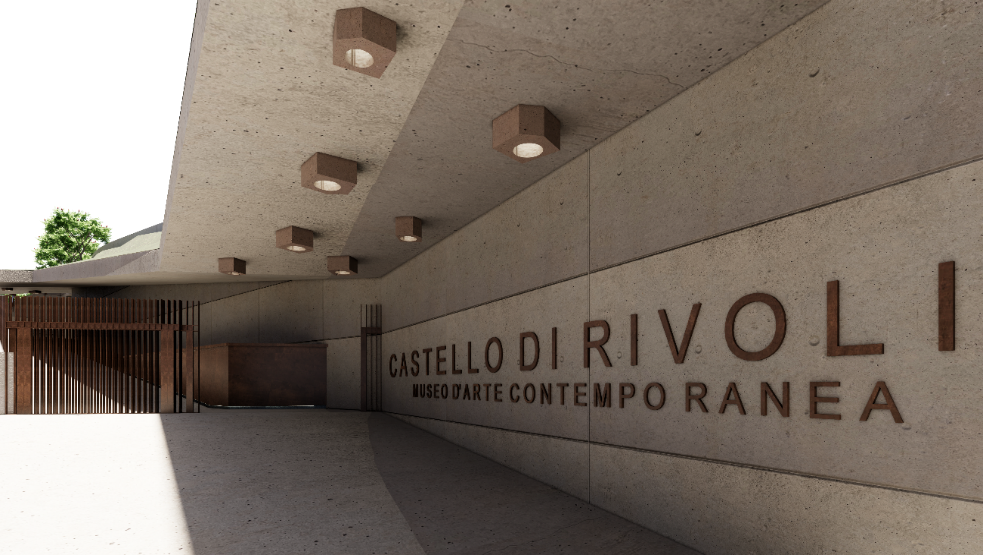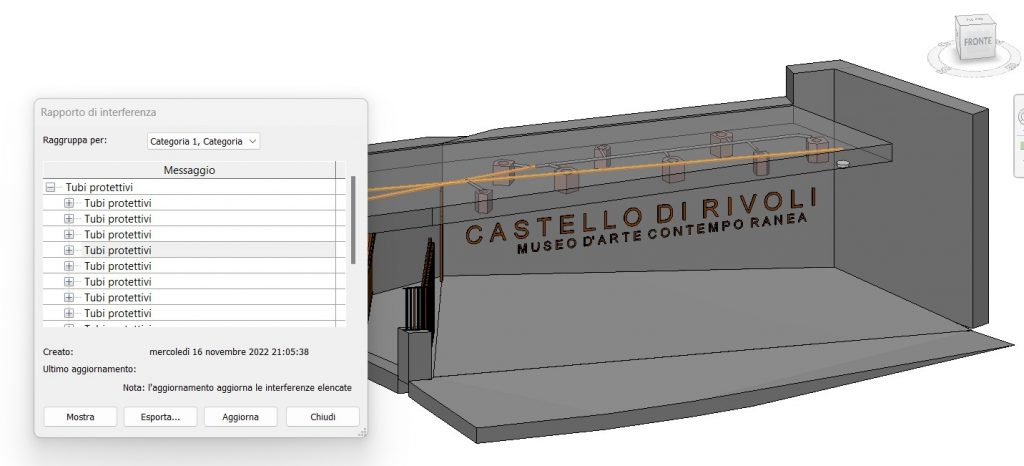AUTORE: Francesca Volpe
TUTOR: Paola Ronca
INTERNSHIP: FOR Engineering Architecture
MASTER: Master in BIM MANAGER a.a 2021/22
La digitalizzazione del settore delle costruzioni è un processo che dura da 50 anni ed è ancora in atto attraverso il BIM, prodotto della rivoluzione digitale ancora in evoluzione, motivo per cui è difficile dare una definizione univoca.
Con l’acronimo BIM si fa riferimento al Building Information Modeling, dove la parola Information è quella più rivoluzionaria: indica la transizione digitale dell’informazione e permette che la stessa sia machine readable, aperta e comprensibile a tutta la filiera delle costruzioni.
Il BIM è un approccio metodologico e processuale di lavoro utilizzato nel settore AECO (Architecture, Engineering, Construction and Operation) per le fasi di progettazione, costruzione, esercizio, manutenzione e gestione.
L’obiettivo di questo progetto di tesi è la presentazione, tramite l’ausilio degli strumenti acquisiti durante il Master, del piano di Gestione Informativa (pGI), definito anche BIM Execution Plan (BEP), riguardante la programmazione e la gestione della fase di progettazione applicata al caso studio con l’intento di supportare l’implementazione della metodologia BIM sul Progetto, dimostrare l’approccio proposto stabilendo le procedure che il team di progettazione deve adottare e produrre informazioni tarate secondo le richieste del caso.
Un ulteriore scopo dello studio di tesi è lo sviluppo digitale di tutte le informazioni di progettazione e costruzione per una possibile estensione del loro uso nella fase di esercizio e gestione attraverso l’utilizzo di un gemello digitale.
Controllo delle interferenze rete di illuminazione e rete FM e dati – Software: Revit
L’elaborato di tesi può essere suddiviso in due parti.
Nella prima parte, si introduce la rivoluzione digitale e come questa sta investendo il settore delle costruzioni esprimendosi nella metodologia BIM.
L’approccio innovativo del BIM e le relative normative di riferimento inquadrano l’argomento principale della tesi, ovvero la costruzione di un modello di piano di gestione informativa e lo sviluppo di un gemello digitale.
Sono mostrate le potenzialità di questa tecnologia, evidenziandone l’importanza del contenuto informativo e quali sono i suoi vantaggi, soprattutto nelle strategie di gestione e manutenzione dell’asset e mostrati i possibili campi di applicazione.
La seconda parte, viceversa, riguarda il caso studio: l’implementazione digitale del progetto di rifunzionalizzazione della risalita al Castello di Rivoli.
In prima fase si è sviluppato il modello di Bim Execution Plan applicato al caso studio, che fa da cornice di riferimento per la conduzione del progetto di costruzione e ottimizzazione del flusso di lavoro.
Nel Piano di gestione informativa sono stabilite le responsabilità, le procedure, i metodi e i protocolli informativi, i software da utilizzare e le modalità di consegna del flusso informativo del progetto.
Il Pgi rappresenta un modello organizzativo di progettazione e dei processi, che si concentra sulla descrizione e sulla mappatura del lavoro da realizzare, permette l’efficientamento dei processi e una migliore gestione del flusso delle informazioni e di lavoro.
Successivamente è mostrato come si è avanzati nello sviluppo del gemello digitale e come questo possa rispondere ai problemi che il caso comporta inizialmente analizzando le categorie del continuum realtà-virtualità di Milgram e Kishino e le relative sfumature di realtà mista esistenti, successivamente sono elencate le tecnologie per la componente hardware e i software utilizzati.
Sono stati esposti gli scenari futuri e i fruitori finali del processo di sviluppo del gemello digitale e le sue applicazioni: ottimizzazione delle attività di manutenzione e di gestione, attività di sicurezza del bene, funzione di mediazione politica e di coinvolgimento sociale, fruizione di una completa esperienza culturale immersiva a portata di tutti.
Infine sono definiti i numerosi vantaggi nel passaggio da un metodo di lavoro tradizionale a un approccio innovativo BIM. Quest’ultimo rappresenta una grande opportunità di investimento finalizzato alla riduzione consistente dei costi e dei tempi, un’occasione di miglioramento nella gestione del progetto, attraverso l’automazione del coordinamento informativo tra gli stakeholders e l’aumento della produttività del team. Fornendo, dunque, i presupposti per una maggiore efficienza delle operazioni di gestione, posta come base affidabile nei processi gestionali e decisionali.
FOR INTERNATIONAL STUDENTS:
The digitization of the construction sector has been going on for 50 years and is still going on through BIM, the product of the digital revolution that is still evolving, which is why it is difficult to give a single definition.
The acronym BIM refers to Building Information Modeling, where the word Information is the most revolutionary: it indicates the digital transition of information and allows it to be machine readable, open and understandable to the entire construction chain.
BIM is a methodological and process approach used in the AECO (Architecture, Engineering, Construction and Operation) sector for the design, construction, operation, maintenance and management phases.
The objective of this thesis project is the presentation, with the help of the tools acquired during the Master, of the Information Management Plan (pgi), also defined BIM Execution Plan (BEP), on the planning and management of the design phase applied to the case study with the intention of supporting the implementation of the BIM methodology on the Project, demonstrate the proposed approach by establishing the procedures for the design team to adopt and produce calibrated information as required.
A further purpose of the thesis study is the digital development of all design and construction information for a possible extension of their use in the operation and management phase through the use of a digital twin.
The thesis paper can be divided into two parts.
In the first part, the digital revolution is introduced and how this is investing the construction sector expressing itself in the BIM methodology.
The innovative approach of BIM and the related reference regulations frame the main topic of the thesis, namely the construction of an information management plan model and the development of a digital twin.
The potential of this technology is shown, highlighting the importance of the information content and its advantages, especially in asset management and maintenance strategies and showing possible fields of application.
The second part, on the other hand, concerns the case study: the digital implementation of the project of re-functionalization of the ascent to the Castello di Rivoli.
In the first phase, the Bim Execution Plan model was developed applied to the case study, which serves as a reference framework for the conduct of the construction project and optimization of the workflow.
The Information Management Plan sets out the responsibilities, procedures, methods and information protocols, the software to be used and the delivery of the project information flow.
The PGI represents an organizational model of design and processes, which focuses on the description and mapping of the work to be carried out, allows the efficiency of processes and a better management of information and work flow.
Later, it is shown how it has advanced in the development of the digital twin and how this can respond to the problems that the case involves initially analyzing the categories of the continuum reality-Milgram and Kishino virtuality and the relative nuances of existing mixed reality, then the technologies for the hardware component and the software used are listed.
The future scenarios and the end users of the development process of the digital twin and its applications were exposed: optimization of maintenance and management activities, asset security activities, function of political mediation and social involvement, Enjoy a complete immersive cultural experience for everyone.
Finally, the numerous advantages in the transition from a traditional working method to an innovative BIM approach are defined. This last one represents a great opportunity of investment finalized to the consisting reduction of the costs and the times, an opportunity of improvement in the management of the plan, through the automation of information coordination between stakeholders and the increase of team productivity. Providing, therefore, the preconditions for a greater efficiency of management operations, put as a reliable basis in management and decision-making processes.




